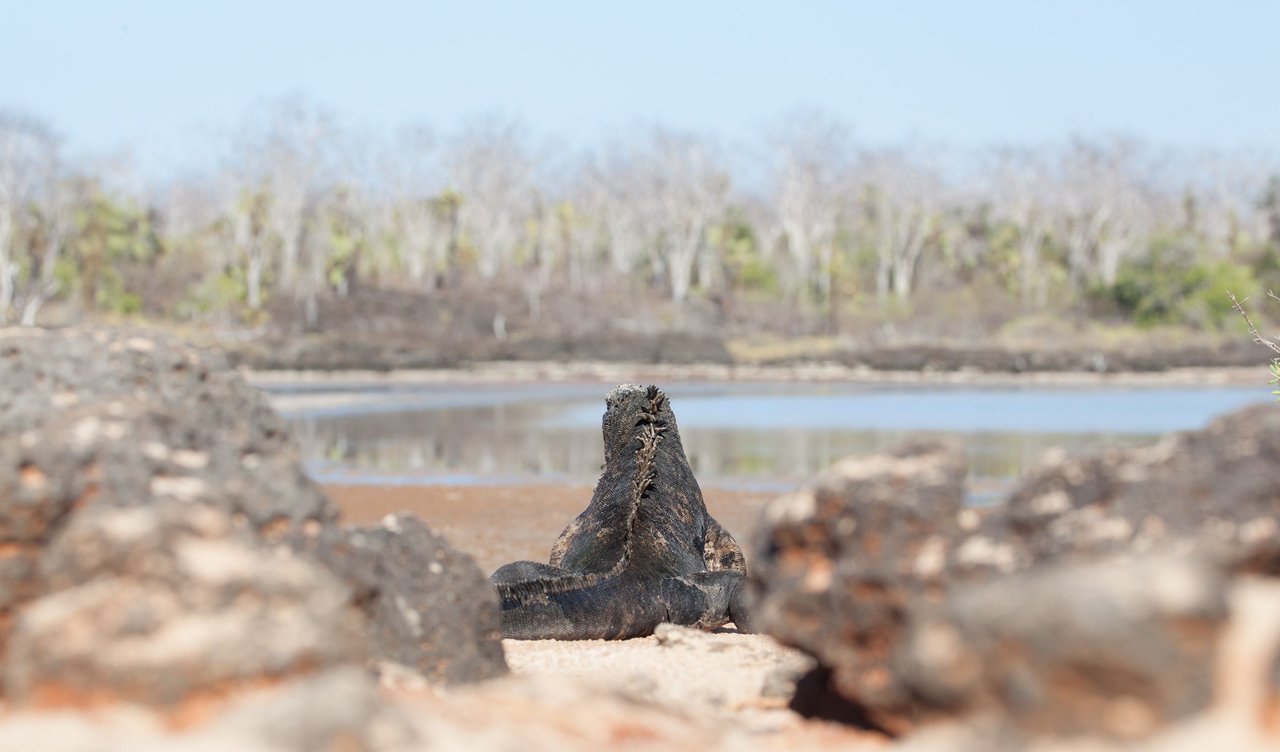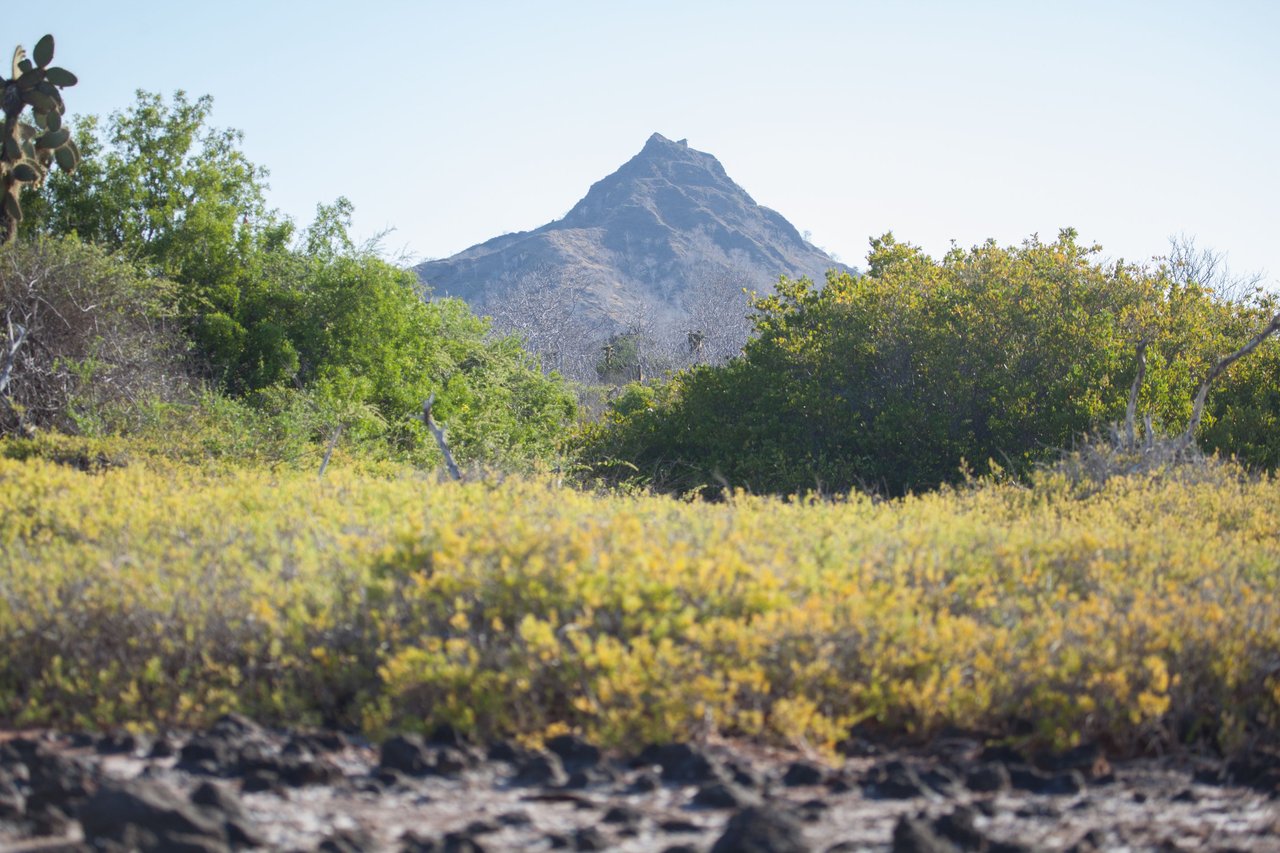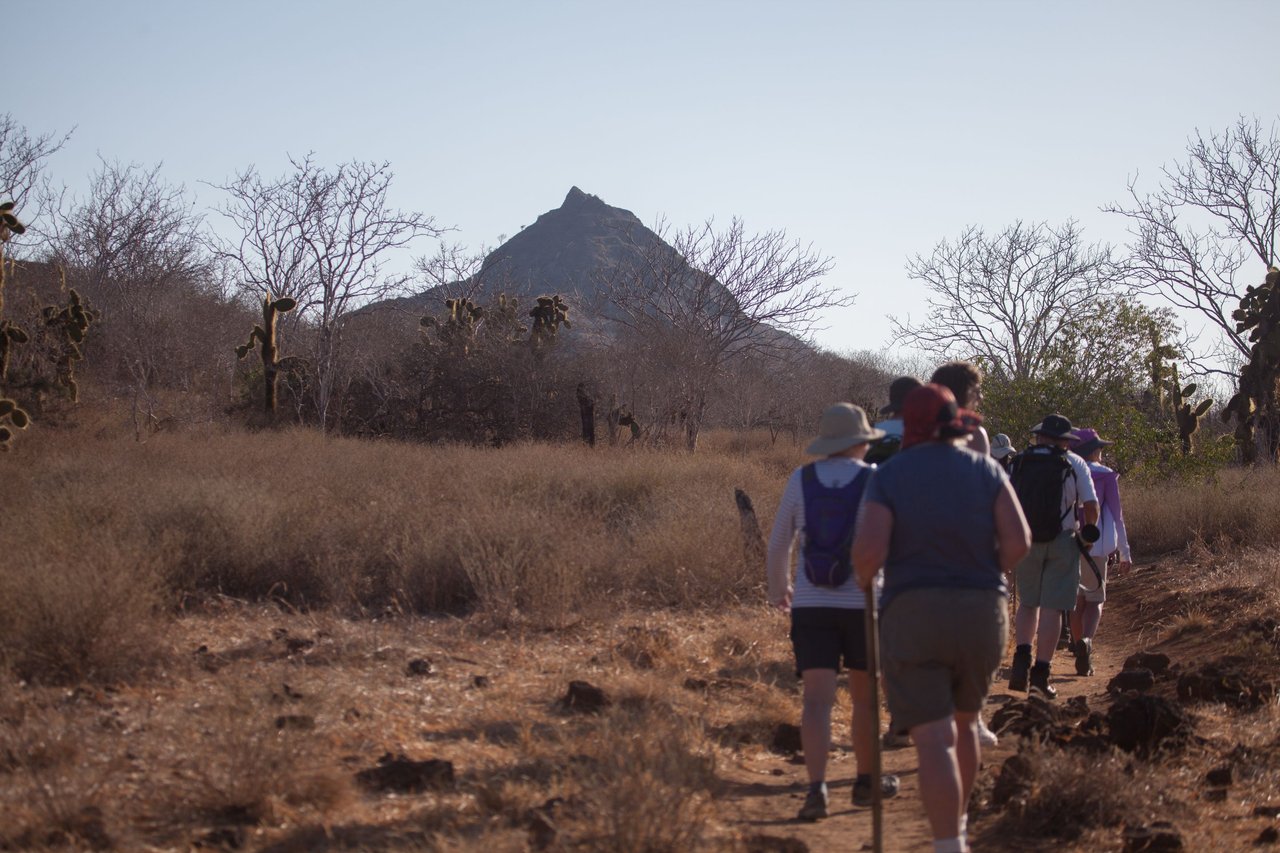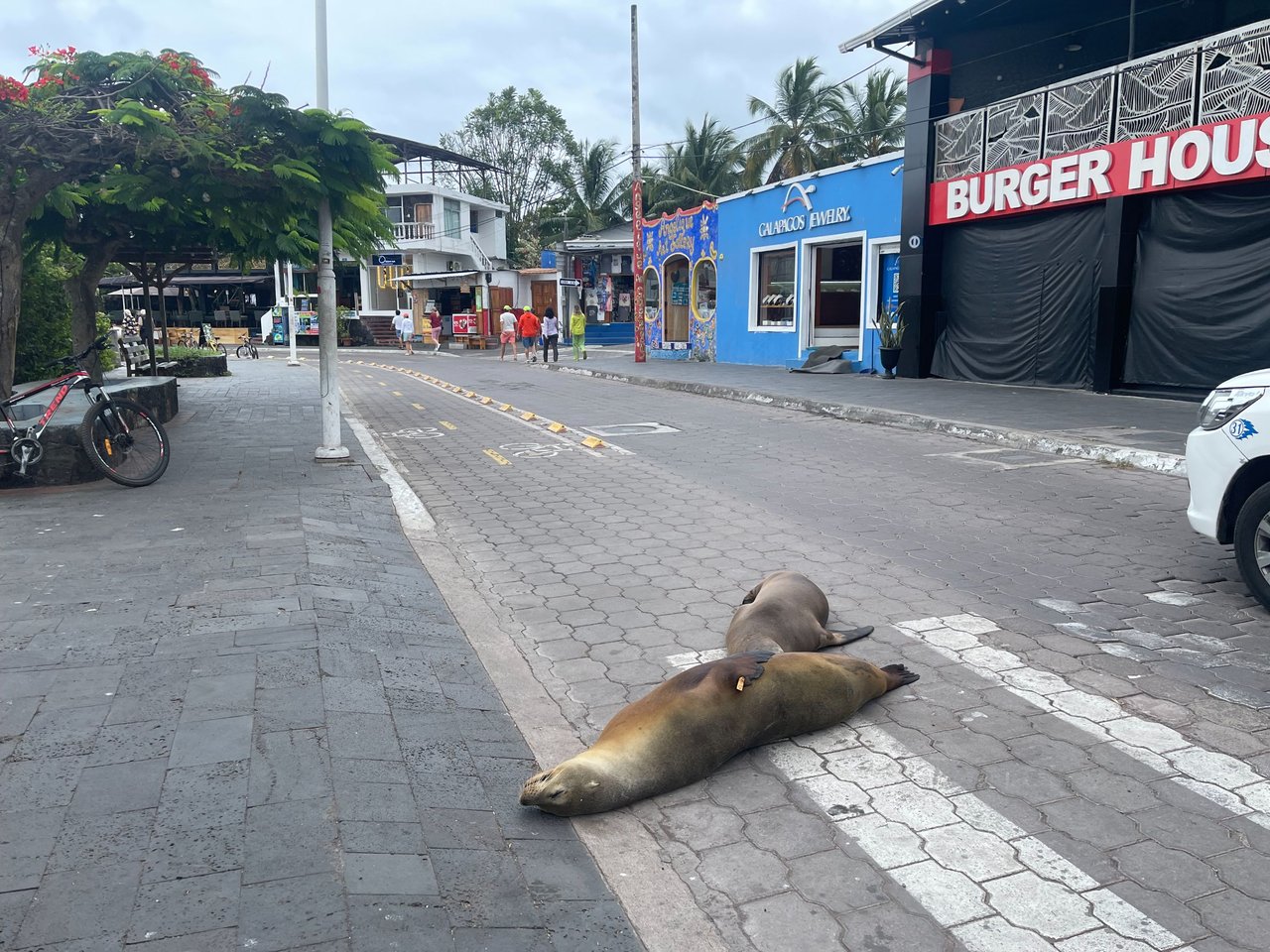Galapagos Day 5: Santa Cruz Island - Hiking Dragon Hill, Learning at the Charles Darwin Research Center in Puerto Ayora, and Walking with Giants in the Highlands
Me and David in the Santa Cruz highlands. It was pretty amazing to be surrounded by these giant, ancient reptiles.
Santa Cruz Island is the commercial hub of the Galapagos Islands. While the island is relatively undeveloped, the main port town of Puerto Ayora does boast 30,000 people. There is a road going for 42km straight across the island from Puerto Ayora, which connects to the airport on the next island of Baltra. This is also the home to the famed Charles Darwin Research Station, where young giant tortoises are raised through their vulnerable early years, before being released into the wild at the age of ten.

Marine iguana enjoying the sunny day.
Many backpackers, who can't afford to go on fancy expedition cruises, will use Puerto Ayora as their base of activities. The town is filled with hotels and hostels, restaurants, and tour operators. I saw advertisements for ferries to other islands, snorkel day trips, and even surf trips, as I walked around the waterfront. But I didn't have to worry about any of that, because our ship takes us to all the different islands, adventuring as we go. And here in Santa Cruz was no different. Over a day and a half we hiked to Dragon Hill, immersed ourselves into the Charles Darwin Research Institute, and traveled to the verdant green highlands to walk amongst the wild giant tortoises.
Dragon Hill:
For this adventure we landed on a very remote part of the northwest coast of Santa Cruz. It was a lava rock landing with patches of beautiful white sand. Tall cacti lined the trail just above the beach. Past the next beach we found resting marine iguanas, some shorebirds in a shallow lagoon (stilts and a whimbrel), and then four flamingos in the next lagoon. We hiked on, looking for land iguanas. We passed quite a few iguana burrows, but had a hard time finding the actual animals in the underbrush. David finally spotted the first female land iguana. We ended up seeing two females and a male. From the top of the hill we could see up into the highlands, noticing the shift from brown to green. The big find came at the very end of the hike. We made it back to the shoreline, and decided to look at some tidepools in the lava rocks while we waited for our pickup. I decided to video one beautiful orange sally lightfoot crab, to show the kids, when all of a sudden, something splashed up out of the nearby tidepool. It took me a moment to realize it was an octopus, lunging out to try and eat the crab.

Reflections of a stilt.
Charles Darwin Research Center:
This is a must see for anyone visiting the Galapagos. It provides a home base for the National Park, as well as researches that have cared for and released over 10,000 giant tortoises. The survival rate for baby tortoises is much greater here, as they don't have to worry about finding enough food, or fighting off predators like the Galapagos hawk, crabs, or rats. I remember my first visit here, being so surprised that the giant tortoises had also evolved into very different looking subspecies on the different Galapagos islands, just like the finches. The adult tortoises at the center at all 'saddle-back', named after their unique shell shape, which allows them to stretch their long necks higher than other Galapagos tortoises to reach leaves as high as six feet.
The most famous tortoise that has come through the research center was Lonesome George, the last of the Pinta Island subspecies. Discovered in 1971, he became a global symbol of conservation. After moving him to the research center, continuous efforts to find him a mate and preserve his genetic lineage were attempted, but never successful. He lived the life of a celebrity at the center until he passed away in 2012. We were able to see his preserved body in a climate controlled room at the station.
It was time for a slow walk back to the docks on the waterfront street filled with shops and restaurants. Lots of folks picked up some souvenirs. I found some little offshoots to the coast, filled with resting sea lions, hungry pelicans, and little marine iguanas. There were a few black tip reef sharks swimming around the docks. Before long, our zodiacs whisked us across the bay to another little dock, where we took a cool nature walk to the Finch Bay Hotel for lunch. They were making some killer drinks, mine was a delicious moscow mule, and had a big buffet set up for us. David and I were the only ones to take advantage of the pool after lunch, which was a missed opportunity since white-cheek pintail ducks and lava gulls were sharing the water with us.
Wild Tortoises in the Santa Cruz Highlands:

This was one of the big saddle back giant tortoises at the Charles Darwin Research Center.
After seeing all of those cute baby tortoises in the Charles Darwin Research Center, and a delicious lunch, it was time to catch a bus up into the highlands to go find some giant tortoises on their home turf. I remember last time I went on this excursion we got saw a dozen or so giant tortoises there...not this time. Nope. This time there were hundreds! We could each pick out own tortoise to hang out with if we liked. Many people stuck with the guides, but I just picked a couple of active tortoises to sit and watch for a while. Several of them walked right by me, as they chomped on grass. One got so close that I started wondering if it would break my bones if it stepped on me. The whole experience was quite magical, and I couldn't help being optimistic about the future survival of the Galapagos giant tortoise.
When we finally returned to our ship, after being away all day, our bartender had spicy chili marguritas and empanadas ready to go. But that wasn't the only surprise. During dinner we noticed a few folks onboard that we didn't recognize. It turns out that an entire local band, complete with dancers was brought onboard. They surprised us with a wonderful performance in the ship's lounge after dinner. What a way to end our time on the wonderful island of Santa Cruz.

The shallow pond at the start of the Dragon Hill hike was home to several migrating water birds like this black neck stilt.

We had a great encounter with this Darwin Finch on the Dragon Hill hike.

Here is the female finch, finding some goodies to eat.

Whimbrel on the flats. I just missed having the full reflection of this unsual bird in the shot.

Giant tortoise close up.

This was one of the few marine iguanas that was relaxing on these colorful succulents instead of the black lava rocks.

Marine iguana with its back to the sea, looking inland. I wonder what they think when they come across the land iguanas.

It seemed like everyday here in the Galapagos, a random yellow warbler shows up.

Guide Indira, ready for the Dragon Hill hike.

View of Dragon Hill from near the landing site.

Hiking through the dry landscape, checking left and right for camouflaged land iguanas. We ended up seeing three.

The necks on these giant tortoises are quite impressive. They can reach leaves up to six feet off the ground!

This was the only galinule we found.

These cactus are great places to look for land iguanas. The thorns started to glow as the setting sun backlit them on our hike back.

I really wanted to see this tortoise try and get out of its mud hole.
The famous Lonesome George. His body is preserved here at the research station where he was cared for since his discovery as the only giant tortoise on La Pinta Island.
The pool beckons at the Finch Bay Hotel on Santa Cruz Island.
David and his tortoise.
This fishermen is cutting a big fish, while the hungry pelicans are closing in around him.
Me trying to talk some sense into my good buddy, Charles Darwin. I told him to go forget about Galapagos, and go to Hawaii instead, where he would have found 54 different species of finch...all evolved from one finch ancestor. He didn't budge.
Welcome to what feels like the central hub of Galapagos.
David, sporting his Guatemalan hat and Ecuadorian hair cut, enjoying the meal at the Finch Bay Hotel.
You really have to watch where you drive around this town. You could have nursing sea lions in the middle of the crosswalk.
I can fully understand why they would turn these islands into a national park, and label it a UNESCO World Heritage Site.













Comments
Post a Comment
Leaving a comment is a great way to provide feedback, ask further questions, and inspire more answers...so go for it.